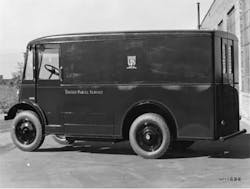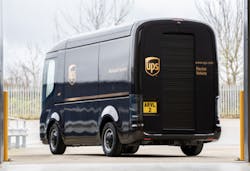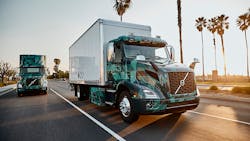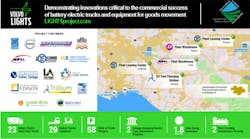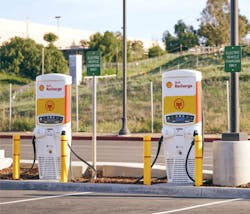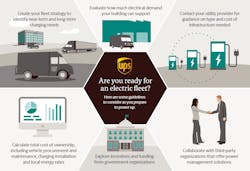With the right plan and duty cycle, there’s plenty to be excited about in regards to fleet electrification, a panel of sustainable trucking experts agreed during a webinar called “A Beginner’s Guide to Electrification.”
“A lot has changed over the last five years,” said Patrick Browne, director of global sustainability at UPS, referring specifically to the medium-duty sector. “Battery pricing is down, and we're starting to get very close to cost parity with electric vehicles (EVs) versus a gasoline or diesel counterpart.”
That excitement may best be described in orders. UPS expects to add 10,000 electric vans from the U.K.-based Arrival and 1,000 from Cincinnati-based Workhorse, which has the added complexity of drone delivery.
The panel also consisted of Aravind Kailas, the Advanced Technology Policy Director at Volvo Group, and Henrik Holland, COO at Greenlots, a Shell Energies company that provides EV charging solutions. They answered a wide range of questions on getting started, from infrastructure and incentives to managing expectations and best regions to start. The event was hosted by the nonprofit Driving Goodness Amplified.
It is important to remember is that everyone’s guidebook is going to look different, with Browne reiterating that there is no “silver bullet.” With that in mind, here’s a sampling of insights that should provide sufficient ammo to help any fleet hit its first electric vehicle targets.
Mapping out a strategy
“What most people don't know is that UPS has been testing alternative fuel vehicles since 1930, when we first started getting electric vehicles in our fleet,” Browne relayed. That’s more than 90 years of experience in some form or another of EVs, and the logistics company is already phasing out its first fleet of modern medium-duty electric box trucks.
UPS is a clear sustainability leader and plans on cutting its absolute greenhouse gas emissions by 12% across its global ground operations by 2025, using 2015 as the baseline. One out of every four vehicles added to the fleet must use alternative power, from battery-electric to compressed natural gas, with the company's Rolling Laboratory fleet comprising 10,300 vehicles; about 1,000 are fully electric or hybrids. UPS has also spent more than $1 billion in the last decade on developing these fuels, technologies and infrastructure to sustain them. The medium-duty trucks may drive as few as 10 miles to as many as 200 miles in a day.
“Electric vehicles are great, but at the end of the day, the greenest mile is the mile we never drive at all,” Browne said. “So we're always at that mindset of figuring out how do we eliminate miles first, and then think about switching over to all different types of alternatives.”
One way UPS does this for the last-mile segment is through its Access Point network, where customers can pick up parcels from consolidated pickup areas, such as a drug store chain or UPS Store, in their neighborhood as opposed to getting packages dropped off on their doorstep.
Consolidate communication
This year, Volvo Group, a leader in Class 8 truck production, began a far-reaching project called the LIGHTS (Low Impact Green Heavy Transport Solutions) project, representing $90 million in public-private investment and 15 partners for the purpose of discovering the best ways to implement Class 8 electric trucks. This project will include 23 trucks total in the Southern California area, with a few on the road now.
The project is not yet in full swing, but early advantages and challenges have already been uncovered. As with the management of any large project, streamlined communication is paramount.
The associated verticals include charging infrastructure, the software provider, engineering and the civil contractors who are getting used to working with high power equipment, and several layers of the supply chain, to name a few.
Although it's a daunting task, Kailas has a fix that should come as no surprise to those familiar with project management.
“We have realized that having a single point of contact in every entity that is being a part of this project is very beneficial, but I think the big takeaway for all of us is that having clear communication will help get things flowing and build mutual respect,” Kailas said.
Communication should start now, as several factors working in an electric-curious fleet’s favor currently exist, with Kailas citing the Advanced Clean Truck rule and NOx rule that the California Air Reserve Board (CARB) passed, as well as the zero emissions pact leaders from 15 states and Washington D.C. signed.
“There's a technology push, there's a market pull, and then the policy or the regulatory push is also aiding this,” Kailas said.
Unlocking the grid
Providing enough electrons to these burgeoning fleets in lieu of an aging national power grid is a challenge Holland and Greenlots, which worked with Volvo Trucks for the LIGHTS project, happily accept. Holland sees opportunity within the complex problem of how to increase the variable load behind the meter on the customer premises and how to deliver the energy.
“I think that is a real systems challenge that we will have to deal with as a society, and, from a political perspective, decide how we're going to invest in that space,” he said.
In the near-term, being “able to smartly manage the charging of the vehicles on-site in conjunction with monitoring and managing a site load” will be a top priority, and it is facilitated by Greenlots’ “smart charging” software.
Another area to contemplate is on-site power generation and the formation of microgrids. Methods may include a photovoltaic system, hydrogen storage, and for now, even gas-fired power. “There's a lot of diesel backups still in the market for these types of situations,” Holland said.
This may seem counterintuitive, but California is vulnerable to rolling blackouts, and while a customer may appreciate zero-emission goals, they probably would prefer they get their order on time instead of waiting for the community to turn their thermostats to 78 degrees F.
“If you have more flexible capacity, stored energy on-site in vehicle batteries, for example, some of that energy might be able to be utilized to balance some of that out,” Holland said.
A fleet ought to think long and hard what that balance looks like for them.
“If sustainability is your primary driver, you might end up with a different solution than if pure total cost of ownership is your key driver,” Holland said. “So I think really understanding what your true drivers are, and then thinking through what your fleet strategy is and what those use cases look like [will allow you to] hit and deliver on those value drivers.”
Do the math
Making a checklist and understanding immediate and future needs are also critical, Browne said. One way to start calculating electric capacity needs first, which is your end point, and working back to see how various trucks and what charging and grid configuration work best.
A fleet also needs to factor in return on investment, because a project that burns cash to go green is destined for failure.
“This is invested capital, and what is that return on that working capital?” Browne asked. “You have got to look at all the types of costs of ownership and everything that you're going to be comparing, like electric versus diesel.”
Browne did affirm total cost of ownership is aided by reduced maintenance costs from eliminating the internal combustion engine, but new costs always pop up with new technology, such as smart charging. Unlike diesel or gas-powered trucks, battery-electric vehicles may offer opportunities for new funding assistance. On incentives and grants, Browne said, “I think they're great, take advantage of them.”
Kailas concurred.
"You definitely want to monitor the funding opportunities that come from the different state agencies," he said. "So that is something that the Volvo Group does regularly: working with its dealership and also our customers."
About the Author
John Hitch
Editor
John Hitch is the editor-in-chief of Fleet Maintenance, providing maintenance management and technicians with the the latest information on the tools and strategies to keep their fleets' commercial vehicles moving. He is based out of Cleveland, Ohio, and was previously senior editor for FleetOwner. He previously wrote about manufacturing and advanced technology for IndustryWeek and New Equipment Digest.

